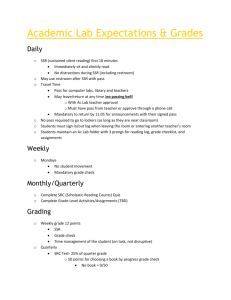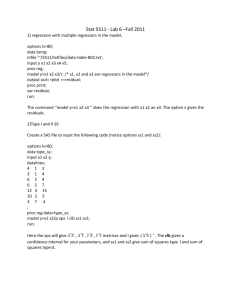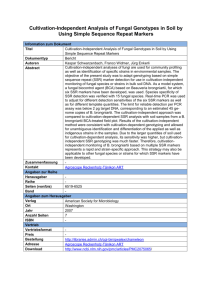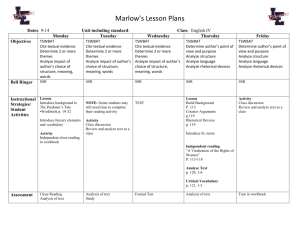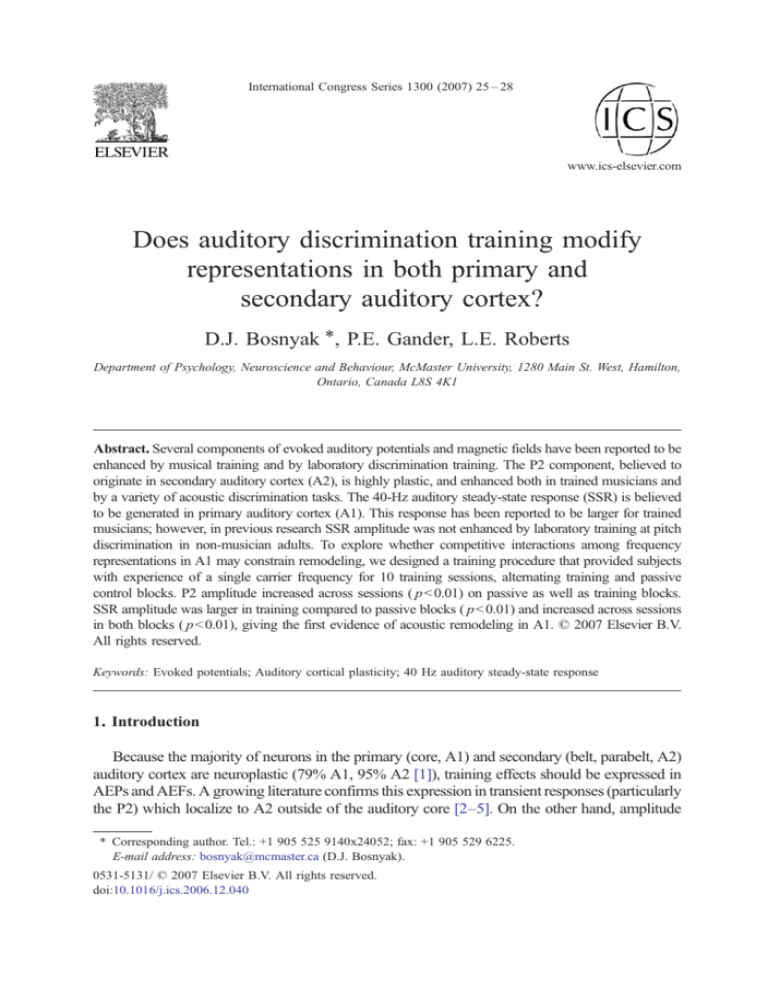
International Congress Series 1300 (2007) 25 – 28
www.ics-elsevier.com
Does auditory discrimination training modify
representations in both primary and
secondary auditory cortex?
D.J. Bosnyak ⁎, P.E. Gander, L.E. Roberts
Department of Psychology, Neuroscience and Behaviour, McMaster University, 1280 Main St. West, Hamilton,
Ontario, Canada L8S 4K1
Abstract. Several components of evoked auditory potentials and magnetic fields have been reported to be
enhanced by musical training and by laboratory discrimination training. The P2 component, believed to
originate in secondary auditory cortex (A2), is highly plastic, and enhanced both in trained musicians and
by a variety of acoustic discrimination tasks. The 40-Hz auditory steady-state response (SSR) is believed
to be generated in primary auditory cortex (A1). This response has been reported to be larger for trained
musicians; however, in previous research SSR amplitude was not enhanced by laboratory training at pitch
discrimination in non-musician adults. To explore whether competitive interactions among frequency
representations in A1 may constrain remodeling, we designed a training procedure that provided subjects
with experience of a single carrier frequency for 10 training sessions, alternating training and passive
control blocks. P2 amplitude increased across sessions ( pb 0.01) on passive as well as training blocks.
SSR amplitude was larger in training compared to passive blocks ( pb 0.01) and increased across sessions
in both blocks ( pb 0.01), giving the first evidence of acoustic remodeling in A1. © 2007 Elsevier B.V.
All rights reserved.
Keywords: Evoked potentials; Auditory cortical plasticity; 40 Hz auditory steady-state response
1. Introduction
Because the majority of neurons in the primary (core, A1) and secondary (belt, parabelt, A2)
auditory cortex are neuroplastic (79% A1, 95% A2 [1]), training effects should be expressed in
AEPs and AEFs. A growing literature confirms this expression in transient responses (particularly
the P2) which localize to A2 outside of the auditory core [2–5]. On the other hand, amplitude
⁎ Corresponding author. Tel.: +1 905 525 9140x24052; fax: +1 905 529 6225.
E-mail address: bosnyak@mcmaster.ca (D.J. Bosnyak).
0531-5131/ © 2007 Elsevier B.V. All rights reserved.
doi:10.1016/j.ics.2006.12.040
26
D.J. Bosnyak et al. / International Congress Series 1300 (2007) 25–28
enhancement of the 40-Hz auditory steady-state response (SSR) localizing to the region of A1
[6,7] has not been successfully demonstrated by training procedures. Bosnyak et al. [2] found only
a brief modulation of SSR phase at ∼200 ms when the subjects were trained to discriminate
changes in the carrier frequency of a steady-state stimulus (a spectral discrimination task).
We hypothesize that competitive interactions within the SSR frequency map may have
constrained expansion of the cortical representation of the trained frequencies in the Bosnyak
et al. study [2]. Here we describe the first of a series of experiments asking whether we can
demonstrate amplitude enhancement of the 40-Hz SSR by acoustic training. The stimulus
procedure adopted for the experiments requires that subjects distribute their attention for the
duration of the steady-state stimulus (attention gating changes in A1 via the basal forebrain
[8,9]) and exposes them to only a single carrier frequency thus reducing competitive
interactions in the frequency map. The experiments are guided by the proposed principle that
under the conditions of attention the auditory cortex encodes its acoustic experience.
2. Methods
Nine experimental subjects and five controls aged 20–28 years (mean 23 years, 7 male,
students at McMaster University) provided written consent. They were paid for participation
and some received partial course credit. All were tested for normal hearing.
The stimulus was a 2 kHz tone 1 s in duration, amplitude modulated (AM) at 40.96 Hz. In
two thirds of the stimuli, a single pulse in the 40-Hz train was amplitude-enhanced in one of
three positions (randomly) in the second half of the stimulus (target). All stimuli were
presented binaurally at 60dB SPL via Etymotic ER2 ear inserts.
Each experimental session consisted of 10 training and 10 passive blocks alternating,
each about 2.5 min in duration. During the training blocks (each containing 27 stimuli, 18
with targets) subjects were instructed to indicate with a button press after each trial whether
Fig. 1. A. P2 amplitude over sessions in the Experimental group for training and passive bocks. B. SSR amplitude
over sessions in the Experimental group for training and passive blocks. C. Comparison of SSR amplitude in the
Experimental and Control groups before and after training. D. Time domain SSR (upper) and polar plots (lower,
dark FCz) before and after training in the Experimental Group, for the training blocks.
D.J. Bosnyak et al. / International Congress Series 1300 (2007) 25–28
27
they detected a target (continuous performance task). Feedback was given following the
response. The SOA was ∼ 3 s. The passive block consisted of an identical set of trials but
subjects were instructed to stop responding and ignore the stimulus.
Experimental subjects (Group E, n = 9) received 4 training sessions at weekly intervals
(spaced practice) followed by 6 more at daily intervals (massed practice) which
accommodated their academic schedule (10 sessions overall). EEG was recorded in sessions
1–4 and 10. Control subjects (Group C, n = 5) received two training sessions aligned in time to
sessions 1 and 10 of Group E.
128 channel EEG (Biosemi ActiveTwo) was sampled at 512 Hz (low pass-3dB at 100 Hz,
reference at Cp1 and ground at Cp2 10-10). EEG responses were epoched into 1 s segments
with 200 ms pre/post baselines. After selecting approximately 90% artifact-free segments,
data were averaged and re-referenced to an average reference. Transient responses were
extracted after filtering 1–20 Hz. For SSR responses the averages were filtered 40–42 Hz.
All waveforms and results reported in this preliminary analysis were calculated on electrode
FCz where the SSR typically reaches its amplitude maximum.
3. Results
3.1. Behavioural results
All subjects showed behavioural improvement across sessions ( p b 0.004). Mean Threshold
(50% hit rate) decreased gradually from 32% enhancement on Day 1 to 20% enhancement on
Day 10.
3.2. Transient responses
P2 amplitude increased across sessions (Fig. 1A), reaching a final amplitude ∼50% greater
than at outset ( pb 0.001). Although the effect of attention (training versus passive blocks) was not
significant for P2, its enhancement by training was more pronounced under passive conditions,
probably because N2 was enhanced when subjects attended to the stimuli during training. The
Control group showed no significant effect of session on P2 amplitude (results not shown).
3.3. Steady-state response
Experimental and control subjects differed in the amount of training delivered over 6 weeks
(10 versus 2 sessions, respectively), but their initial and concluding evaluations were performed at
the same time. For the Experimental group, the effect of session was significant ( p= 0.007), with
the SSR generally increasing across sessions (Fig. 1B). Before/after differences were found for
experimental subjects (Fig. 1C, pb 0.04) but not controls ( p=0.23), indicating that the amount of
training and not the passage of time determined the outcome. SSR amplitude was enhanced in the
training as well as passive blocks, which differed from one another in the Experimental ( p=
0.0001) and Control ( p =0.033) groups pointing to SSR enhancement by attention. Enhancement
of SSR amplitude in the Experimental group was evident throughout the trained stimulus (upper
panel, training blocks) and in polar plots depicting all channels (lower panel, Fig. 1D) where
dipolar patterns suggested a single cortical source contributing to the SSR, putatively in A1.
28
D.J. Bosnyak et al. / International Congress Series 1300 (2007) 25–28
4. Discussion
Behavioral improvements in discrimination ability were accompanied by P2 enhancement,
corroborating previous findings [2–4] and giving a picture of cortical reorganization expressed
in the region of A2. SSR amplitude increased after ten sessions in the experimental group but
not controls, and was modulated by attention in both groups. The enhancement of SSR
amplitude by training seen here contrasts with effects on phase only reported by Bosnyak et al.
[2] where discrimination of carrier frequency was trained. The different outcomes may be a
consequence of our having trained amplitude detection using only a single carrier frequency.
This procedure was developed to reduce competitive interactions in the region of A1 where
surround inhibition is strong and the cortical sources of the SSR typically localize [6,7].
There are qualifications, however. SSR amplitude did not track a steadily increasing
course as P2 did. After an initial increase in the second training session, SSR amplitude did
not grow further until massed training between sessions 5–10. At present we do not know
whether session spacing or number was the relevant variable. Here we used a minimal
control condition. Additional control groups will be required to assess whether SSR
enhancement fails when competing frequencies are added to the training procedure. It may
be noteworthy that P2 was modulated by training and not by attention, whereas the SSR was
modulated by both. This suggests that the rules that describe plasticity and its expression in
the SSR may be different from those describing transient responses. The differences may
reflect properties intrinsic to different regions of the human auditory system.
Acknowledgements
This research was supported by grants from the Canadian Institutes of Health Research and
NSERC of Canada. We thank Dave Thompson and Jing-Jiang Lei for technical assistance.
References
[1] D.M. Diamond, N.M. Weinberger, Physiological plasticity of single neurons in auditory cortex of the cat
during acquisition of the pupillary conditioned response: II, Behav. Neurosci. 98 (1984) 189–210.
[2] D.J. Bosnyak, R.A. Eaton, L.E. Roberts, Distributed auditory cortical representations are modified by training
at pitch discrimination with 40 Hz amplitude modulated tones, Cereb. Cortex 14 (2004) 1088–1099.
[3] K.L Tremblay, N. Kraus, Auditory training induces asymmetrical changes in cortical neural activity, J. Speech
Lang. Hear. Res. 45 (2002) 564–572.
[4] K.S. Reinke, et al., Perceptual learning modulates sensory evoked response during vowel segregation, Brain
Res. Cogn. Brain Res. 17 (2003) 781–791.
[5] H. Menning, L.E. Roberts, C. Pantev, Plastic changes in the auditory cortex induced by intensive frequency
discrimination training, Neuroreport 11 (2000) 817–822.
[6] C. Pantev, et al., Tonotopic organization of the sources of human auditory steady-state responses, Hear. Res.
101 (1996) 62–74.
[7] B. Yvert, et al., Multiple supratemporal sources of magnetic and electric auditory evoked middle latency
components in humans, Cereb. Cortex 11 (2001) 411–423.
[8] R.W. Dykes, Mechanisms controlling neuronal plasticity in somatosensory cortex, Can. J. Physiol. Pharm. 75
(1997) 535–545.
[9] M. Sarter, et al., Unraveling the attentional functions of cortical cholinergic inputs: interactions between signaldriven and cognitive modulation of signal detection, Brains Res. Rev. 24 (2005) 98–111.


